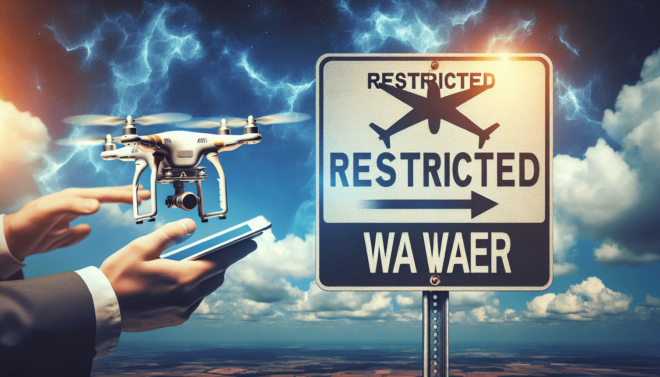How Do I Apply For A Drone Flight Waiver From The FAA?
Overview of FAA Drone Flight Waivers
If you’re looking to fly a drone in the United States for commercial or recreational purposes in restricted airspace, you may need to obtain a waiver from the Federal Aviation Administration (FAA). This article will guide you through the process of applying for a drone flight waiver from the FAA, so you can operate your drone legally and safely.
Understanding Drone Flight Restrictions
Before we dive into the process of applying for a drone flight waiver, it’s essential to understand the different types of drone flight restrictions enforced by the FAA. Depending on your location and the nature of your drone operations, you may encounter various restrictions such as airspace limitations, altitude restrictions, and flight duration limitations. By familiarizing yourself with these restrictions, you can determine if you need to apply for a waiver for your drone flight.
Types of Drone Flight Waivers
There are several types of drone flight waivers available from the FAA, each catering to different scenarios and requirements. The most common types of drone flight waivers include:
-
Part 107 Waiver: Allows commercial drone operators to deviate from certain regulations under Part 107 of the FAA regulations.
-
Airspace Authorization: Grants permission to fly in controlled airspace that would otherwise be restricted without authorization.
-
Night Operations Waiver: Permits drone flights during nighttime hours, provided the operator meets specific safety requirements.
-
Altitude Limitations Waiver: Allows drone operators to fly above the maximum altitude specified in the FAA regulations under Part 107.
Step-by-Step Guide to Applying for a Drone Flight Waiver
Now that you have a better understanding of the different types of drone flight waivers available, let’s walk through the step-by-step process of applying for a waiver from the FAA. Follow these steps to ensure your drone operations comply with federal regulations and safety standards.
-
Determine the Type of Waiver You Need: Start by identifying the specific type of waiver you require based on your intended drone operations. Consider factors such as airspace restrictions, altitude limitations, and any other regulations that may apply to your situation.
-
Create an Account on the FAA DroneZone Portal: To apply for a drone flight waiver, you’ll need to create an account on the FAA’s DroneZone portal. This online platform allows you to submit waiver applications, track the status of your submissions, and manage your drone operations.
-
Complete the Online Application Form: Once you’ve registered on the FAA DroneZone portal, you can proceed to fill out the online application form for the drone flight waiver. Provide accurate and detailed information about your drone operations, including the type of waiver you’re requesting and the specific regulatory requirements you need to deviate from.
-
Submit Supporting Documents: Along with the application form, you may be required to submit supporting documents to substantiate your waiver request. These documents may include operational manuals, safety procedures, risk assessments, and any other information that demonstrates your compliance with FAA regulations.
-
Pay the Application Fee (if applicable): Some drone flight waivers issued by the FAA may require an application fee to process your request. Be sure to check the specific requirements for the type of waiver you’re applying for and submit the payment as instructed.
-
Wait for Review and Approval: After submitting your drone flight waiver application, the FAA will review your request to ensure compliance with safety standards and regulatory requirements. The review process may take some time, so be patient and monitor the status of your application through the DroneZone portal.
-
Receive Approval or Denial Notification: Once the FAA has reviewed your waiver application, you will receive a notification regarding the approval or denial of your request. If approved, you will be issued the necessary documentation to operate your drone within the specified parameters. In the event of a denial, the FAA will provide reasons for the decision and any necessary steps to address the deficiencies in your application.
Tips for a Successful Drone Flight Waiver Application
To increase your chances of obtaining a drone flight waiver from the FAA, consider the following tips and best practices:
-
Provide Detailed Information: When completing the waiver application form, make sure to provide thorough and accurate information about your drone operations, safety measures, and compliance with FAA regulations. The more details you provide, the easier it will be for the FAA to evaluate your request.
-
Follow Safety Guidelines: Demonstrate your commitment to safety by adhering to recommended best practices for drone operations. Develop a comprehensive safety plan, conduct risk assessments, and implement protocols to mitigate potential hazards during your flights.
-
Submit Supporting Documents: Include any necessary supporting documents with your waiver application to validate your compliance with FAA regulations. These documents may include manuals, checklists, operational procedures, and any other evidence that supports your request.
-
Monitor the Status of Your Application: Stay informed about the progress of your waiver application by monitoring the status updates on the FAA DroneZone portal. This will help you track any requests for additional information or clarification from the FAA.
-
Seek Professional Assistance (if needed): If you’re unsure about the application process or require expert guidance, consider consulting with a professional drone operator or aviation specialist. They can offer valuable insights and recommendations to improve your chances of securing a drone flight waiver.
Conclusion
Applying for a drone flight waiver from the FAA may seem daunting at first, but with the right information and preparation, you can navigate the process successfully. By understanding the different types of waivers, following the step-by-step application guide, and implementing best practices for submission, you can increase your chances of obtaining the necessary permissions to fly your drone legally and safely. Remember to always prioritize safety, compliance, and responsibility in your drone operations to enjoy a positive and hassle-free flying experience.

